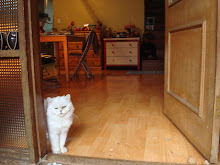Thursday, July 12, 2012
Korea’s First Adoption Center for Rescued Animals Opens
The country’s first adoption center for rescued animals opened Saturday on Toegye-ro ( Dongdaemun - gu), Seoul, ironically, on a street lined with pet shops and puppy mills.
Director of Coexistence of Animal Right on Earth (CARE) Park So-yeon explained that she specifically chose Toegye-ro as the location for CARE’s Adoption Center because the area is famous for puppy mills.
“Hundreds of animals are locked up in small cages for reproducing pets. When the breeding dogs become useless, they are handed over to dog meat sellers. CARE wanted to boycott the ‘puppy mills’ at Chungmu-ro and promote our ‘Adopt, Don’t Buy’ campaign,” explained Park.
“The officially announced number of abandoned dogs is 100,000 a year in Korea, but I’m guessing that it amounts to more than 500,000. The problem comes from an excessive supply of pets, and the problem can be solved by developing a culture of animal adoption.”
CARE, a non-profit organization promoting animal rights, focuses on rescuing abandoned or abused animals. It currently operates an animal shelter, which houses 250 dogs and 50 cats, in Pocheon, Gyeonggi Province.
“Most animal shelters are located in the suburbs, which is not very accessible to the public, and the conditions are inadequate at best. Our CARE shelter also needs more improvement, even though it is the best animal shelter in Korea,” said Park.
Animals admitted in CARE’s Adoption Center are brought in from its shelter. “Animals in the shelter undergo an evaluation, and animals only suitable for adoption are handed over to the adoption center,” explained Park. The adoption center is designed to house 16 dogs on the first floor, while the second floor can house 12 to 16 cats.
According to Park, the animal adoption centers and shelters in the United Kingdom set a good example to follow in establishing animal adoption culture here.
“Animal adoption culture in the United Kingdom is very active due to the well-maintained animal shelters. Information on each animal is kept in an organized way, the shelters are clean, and the caretakers even train dogs,” said Park.
CARE plans to open another adoption center in September at Dapsimni, Seoul.
“Along with animal houses, the new adoption center in Dapsimni will have an experience-based learning center for children as well as animal health care center for low-income pet owners,” said Park.
CARE is currently funded by individual donations, but Park aims to expand the funding to include contributions from corporations.
“CARE hopes to build more adoption centers in collaboration with corporations. It is a win-win solution ― the adoption centers will be a good advertisement for corporations, while CARE will have adequate amount of money to build decent adoption centers,” explained Park.
Coexistence of Animal Right on Earth was established in August 2002, and has some 30,000 members.













